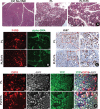Exploring the role of YAP1 and TAZ in pancreatic acinar cells and the therapeutic potential of VT-104 in pancreatic inflammation
- PMID: 40123617
- PMCID: PMC11925344
- DOI: 10.1097/JP9.0000000000000170
Exploring the role of YAP1 and TAZ in pancreatic acinar cells and the therapeutic potential of VT-104 in pancreatic inflammation
Abstract
Background: Increasing evidence has linked the Hippo pathway with the fibroinflammatory diseases. However, the detailed roles of key hippo components in pancreatic inflammatory diseases still remain unclear.
Methods: A series of genetic knockout mice were generated targeting the key components of Hippo pathway to examine the individual effects of YAP1 and TAZ on pancreatic inflammation. Hematoxylin and eosin (H&E) staining, immunohistochemistry, and immunofluorescence staining were performed to evaluate the pancreas tissue from mice with various genotypes. The therapeutic potential of a recently developed YAP1/TAZ inhibitor VT-104 was also evaluated in our mouse model.
Results: Mice with acinar-specific knockout of YAP1/TAZ did not exhibit any histological abnormalities in the pancreas. LATS1/2 deficiency induced acinar to ductal metaplasia, immune cell infiltration, and fibroblast activation, which were rescued by the homozygous knockout YAP1, but not TAZ. Additionally, treatment with VT-104 also decreased pathological alterations induced by deletions of LATS1 and LATS2 in acinar cells.
Conclusion: Our findings highlight the critical role of YAP1 in modulating pancreatic inflammation and demonstrate that VT-104 holds therapeutic potential to mitigate pancreatitis-associated pathological manifestations. Further exploration is necessary to unravel the underlying mechanisms and translate these insights into clinical applications.
Keywords: Fibrosis; Hippo pathway; Inflammation; Pancreatitis; TAP1/TAZ.
Copyright © 2024 The Chinese Medical Association, Published by Wolters Kluwer Health, Inc.
Conflict of interest statement
The authors declare no conflicts of interest.
Figures





Update of
-
Exploring the Role of YAP1 and TAZ in Pancreatic Acinar Cells and the Therapeutic Potential of VT-104 in Pancreatic Inflammation.bioRxiv [Preprint]. 2023 Sep 18:2023.09.18.558321. doi: 10.1101/2023.09.18.558321. bioRxiv. 2023. Update in: J Pancreatol. 2025 Mar;8(1):32-40. doi: 10.1097/JP9.0000000000000170. PMID: 37781601 Free PMC article. Updated. Preprint.
References
-
- Lee PJ, Papachristou GI. New insights into acute pancreatitis. Nat Rev Gastroenterol Hepatol. 2019;16:479–496. - PubMed
-
- Sankaran SJ, Xiao AY, Wu LM, et al. . Frequency of progression from acute to chronic pancreatitis and risk factors: a meta-analysis. Gastroenterology. 2015;149:1490–1500.e1. - PubMed
-
- Ali UA, Issa Y, Hagenaars JC, et al. . Risk of recurrent pancreatitis and progression to chronic pancreatitis after a first episode of acute pancreatitis. Clin Gastroenterol Hepatol. 2016;14:738–746. - PubMed
Grants and funding
LinkOut - more resources
Full Text Sources
Research Materials
